Your walking boots are arguably the most important piece of kit you’ll invest in as a hiker. Get them right, and you’ll enjoy comfortable, blister-free miles on the trail. Get them wrong, and even the most beautiful British landscape will feel like torture. With hundreds of models available and prices ranging from £50 to £400+, choosing the right boots can feel overwhelming — which is why a well-researched walking boots buying guide can make all the difference
This comprehensive guide will walk you through everything you need to know to find the perfect pair of walking boots for your needs, budget, and the unique demands of hiking in the UK.
Important note: Boot choice is highly subjective and personal. What works brilliantly for one hiker may be uncomfortable for another, even with identical foot measurements. This guide reflects general principles and popular recommendations, but your individual experience, foot shape, hiking style, and preferences are ultimately what matter most. Use this as a starting point, but trust your own feet when making the final decision.
Understanding Boot Categories
Before diving into features and brands, it’s crucial to understand that not all walking boots are created equal. They’re designed for different types of hiking, and choosing the right category is your first decision.
Walking Shoes (Category A)
Best for: Easy, low-level paths, canal towpaths, gentle countryside walks, urban trails
Characteristics:
- Lightweight and flexible
- Low-cut ankle design
- Minimal ankle support
- Usually fabric and synthetic construction
- Quick-drying
- Less durable than boots
UK terrain suitability: Fine for the Cotswolds, South Downs Way, easy Peak District paths on dry days. Not suitable for very muddy conditions, rough terrain, or carrying heavy loads.
Price range: £40-£120
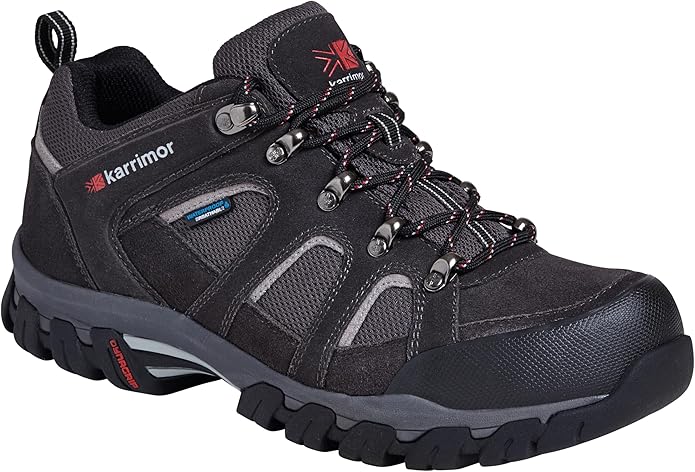
Lightweight Hiking Boots (Category B)
Best for: Day hiking, well-maintained trails, weekend walks, Year-round use on lower hills
Characteristics:
- Mid-height ankle support
- Mix of leather and synthetic materials
- Moderate waterproofing (usually Gore-Tex or similar)
- Flexible but supportive sole
- Good for most UK day hiking
UK terrain suitability: Perfect for Lake District valleys, Scottish Munro approaches, Peak District trails, Yorkshire Dales. The most versatile option for British hiking.
Price range: £80-£180
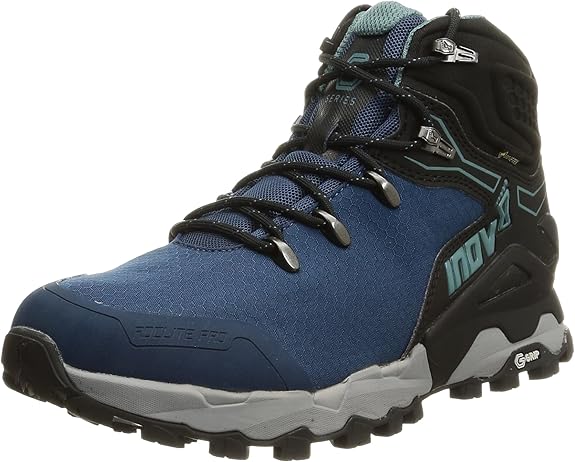
Trekking Boots (Category B+/C)
Best for: Multi-day hiking, rough terrain, carrying heavier loads, all UK mountain ranges
Characteristics:
- Full ankle support
- Predominantly leather or heavy-duty synthetic
- Excellent waterproofing
- Stiffer, more supportive sole
- Greater durability
- Heavier weight
UK terrain suitability: Scottish Highlands, Lake District peaks, Snowdonia, challenging Peak District routes, winter conditions. Essential if you’re carrying camping gear or tackling serious mountains.
Price range: £120-£300+

Mountaineering Boots (Category C/D)
Best for: Winter mountaineering, Scottish winter climbing, crampon-compatible hiking
Characteristics:
- Very stiff sole (crampon-compatible)
- Full leather or synthetic leather
- Maximum ankle support
- Insulated options available
- Designed for technical terrain
- Very durable but heavy
UK terrain suitability: Scottish winter routes, scrambling, anything requiring crampons. Overkill for most UK summer hiking.
Price range: £200-£500+

Trail Running Shoes: A Modern Alternative
Best for: Fast-paced hiking, dry conditions, lightweight enthusiasts, well-maintained trails
In recent years, many experienced hikers have switched from traditional boots to trail running shoes, and for good reason. This approach, sometimes called “fast and light” hiking, offers several advantages:
Benefits:
- Significantly lighter: Typically 300-500g per shoe vs 600-900g for boots
- More natural foot movement: Allows your feet and ankles to strengthen naturally
- Faster drying: If they get wet, they dry much quicker than boots
- Less break-in required: Usually comfortable from the first wear
- Better on technical terrain: More ground feel and agility
- Cooler in summer: More breathable than boots
Drawbacks:
- Less ankle support: Higher injury risk on uneven terrain for some people
- Less durable: Typically last 500-800km vs 1000-2000km for boots
- Water resistance, not waterproof: Your feet will get wet in sustained rain
- Less protection: More vulnerable to sharp rocks and stubs
- Require stronger ankles: Not suitable if you have weak or previously injured ankles
UK-specific considerations for trail runners:
British terrain and weather present unique challenges for trail running shoes:
- Mud performance: Modern trail runners actually excel in mud with aggressive lugs (look for models like Salomon Speedcross or Inov-8 Mudclaw)
- Wet feet acceptance: Many UK hikers using trail runners embrace the “wet feet” philosophy – rather than fighting to keep feet dry, they accept they’ll get wet and rely on quick drying
- Seasonal use: More practical for spring/summer hiking; winter conditions often favour boots
- Load carrying: Fine for day packs up to 8-10kg; heavier loads really benefit from boot support
Who should consider trail runners:
- Experienced hikers with strong ankles
- Those hiking primarily on well-maintained paths
- Fast-paced hikers and ultralight backpackers
- People who find boots too heavy or restrictive
- Those doing shorter day hikes in good weather
Who should stick with boots:
- Beginners still developing ankle strength
- Anyone with ankle instability or previous injuries
- Those carrying heavy loads (15kg+)
- Hikers tackling very rough, rocky terrain
- Winter hiking in snow and ice
- Multi-day expeditions in remote areas
Popular trail running shoe options for UK hiking:
- Salomon Speedcross: Aggressive grip, excellent in mud
- Inov-8 Roclite/Mudtalon: UK brand, designed for British conditions
- Hoka Speedgoat: Maximum cushioning, good for long distances
- La Sportiva Bushido: Technical terrain specialist
- Altra Lone Peak: Wide toe box, zero-drop design – I wore these to walk the Tour Du Mont Blanc and loved them.
Price range: £80-£150
Pro tip: Some hikers carry lightweight trail runners for easier sections and have boots available for technical terrain – particularly useful on multi-day trips with varied conditions.

Key Features to Consider
Once you’ve identified your category, focus on these essential features:
1. Waterproofing
In the UK, this is non-negotiable. British weather means your boots will encounter rain, bogs, stream crossings, and morning dew regularly.
Membrane technologies:
- Gore-Tex: Industry standard, excellent breathability and waterproofing
- eVent: Similar to Gore-Tex, some find it more breathable
- Proprietary membranes: Brands like Scarpa, Salomon, and Berghaus have their own systems
- Treated leather: Full-grain leather naturally water-resistant when properly waxed
Reality check: No boot is 100% waterproof if you’re walking through deep water or in sustained heavy rain for hours. Waterproofing keeps out moisture from light rain, puddles, and dew, but eventually water will find its way in through the top if you’re wading through bogs.
Pro tip: Pair waterproof boots with waterproof gaiters for maximum protection in wet conditions.
2. Ankle Support
The level of ankle support you need depends on three factors:
- Terrain roughness: Rocky, uneven ground needs more support
- Load weight: Heavier backpacks require stiffer boots
- Your ankles: Previous injuries or weak ankles benefit from higher support
Low-cut (shoes): Maximum flexibility, minimal support. Fine for easy trails and strong ankles.
Mid-height: The sweet spot for most UK hiking. Provides support without restricting movement.
High-cut: Maximum support for rough terrain and heavy loads. Can feel restrictive on easy ground.
3. Sole Construction and Grip
The sole is what connects you to the ground—arguably more important than any other feature.
Vibram soles: The gold standard. Look for:
- Vibram Megagrip: Excellent for wet rock and general use
- Vibram Mulaz: Good all-rounder for trekking boots
- Vibram Tsavo: Designed specifically for UK/Alpine mixed terrain
Tread pattern: Deep, widely-spaced lugs shed mud better than fine treads. Essential for British trails.
Sole stiffness: Measured on a scale from flexible (walking shoes) to rigid (mountaineering boots). More stiffness means:
- Better support on uneven ground
- Less foot fatigue on rocky terrain
- Compatibility with crampons (if very stiff)
- But less natural feeling on easy paths
Heel brake: Look for a defined heel area with aggressive lugs for braking on steep descents.
4. Materials and Construction
Full-grain leather:
- Most durable option
- Excellent waterproofing when treated
- Naturally breathable
- Requires breaking in and maintenance
- Heavier
- More expensive
- Best for serious hiking and longevity
Nubuck leather:
- Slightly more flexible than full-grain
- Good durability
- Requires treatment to maintain waterproofing
- Mid-weight
- Good balance of performance and comfort
Synthetic materials:
- Lightweight
- Quick-drying
- Minimal break-in period
- Less durable than leather
- Waterproofing depends on membrane
- Often cheaper
- Good for warmer conditions
Split leather/synthetic mix:
- Most common in mid-range boots
- Good balance of weight, durability, and cost
- Waterproof membrane usually required
5. Fit and Comfort Features
Toe box: Should allow you to wiggle your toes. On descents, your foot slides forward—if your toes hit the front, you’ll get black toenails and serious discomfort.
Heel cup: Should hold your heel firmly without slipping. Heel lift causes blisters.
Lacing system:
- Traditional eyelets: Most durable, easy to replace
- D-ring hooks: Easier to tighten, quicker
- Speed lacing: Fast but can be finicky
Padded collar: Protects ankles and prevents rubbing.
Tongue gusset: Keeps water and debris out. Essential for British muddy trails.
Removable insole: Allows you to replace with custom orthotics if needed.
The Fitting Process: Getting It Right
More boots fail due to poor fitting than any manufacturing defect. Here’s how to ensure a perfect fit:
When to Shop
Afternoon or evening: Your feet swell during the day. Boots that fit perfectly in the morning may feel tight after a day’s hiking.
After a walk: If possible, go boot shopping after a hike when your feet are at their largest.
What to Bring
- The socks you’ll actually hike in (thick hiking socks, not thin daily socks)
- Any orthotics or insoles you use
- Your current boots (to show wear patterns to staff)
The Fitting Steps
- Measure both feet: Feet can differ in size. Fit to the larger foot.
- Try on both boots: One foot is often slightly larger than the other.
- Lace properly: Start loose at the toe, tighten through the middle, secure at the ankle.
- Heel check: Unlaced, your heel should lift slightly. When properly laced, heel lift should be minimal.
- Toe test: With boots laced, kick your toe firmly into the ground. Your toes shouldn’t hit the front. On a downward slope (most shops have a ramp), your toes should have clearance.
- Walk around: Spend at least 10-15 minutes walking. Use stairs or slopes if available. Your feet should feel secure but not compressed.
- Wear them at home: Many outdoor retailers allow home trials. Wear boots indoors for a few hours. If they’re uncomfortable, return them. Don’t wear them outside until you’re certain.
Fit Warning Signs
Too tight if:
- Toes touch the front
- Pressure points on sides or top of foot
- Numbness or tingling
- Pain after 15 minutes
Too loose if:
- Heel lifts significantly when walking
- Foot slides forward on descents
- Excessive movement inside boot
Pro tip: If in doubt between sizes, go up. You can add thicker socks or insoles to a slightly large boot, but you can’t make a too-small boot bigger.
Breaking In Your Boots
Leather boots require breaking in. Synthetic boots need minimal break-in but still benefit from gradual use.
Break-In Process
Week 1: Wear around the house for 30-60 minutes daily Week 2: Short walks on easy terrain (1-2 hours) Week 3: Longer walks with some elevation (3-4 hours) Week 4: Full day hikes on varied terrain
Never: Wear brand new boots on a multi-day hike or challenging route. This is a guaranteed recipe for blisters and misery.
Speeding Up Leather Break-In
- Wear thick socks
- Use leather conditioner on the exterior
- Flex the boots manually with your hands
- Wear them little and often rather than one long session
UK-Specific Considerations
British hiking presents unique challenges that should inform your choice:
The Mud Factor
British trails are muddy. Especially in autumn, winter, and spring (which covers about 9 months of the year in some areas). Choose boots with:
- Deep, widely-spaced lugs that shed mud
- Full ankle coverage to keep mud out
- Easy-to-clean materials
The Weather
Waterproofing is essential, but so is breathability. UK conditions often mean:
- Walking in rain then sunshine on the same day
- Working up a sweat in waterproofs
- Humid conditions even when not raining
Look for boots with excellent breathability (Gore-Tex or equivalent) to prevent your feet becoming sweat-soaked inside waterproof boots.
The Terrain
UK hiking offers everything from gentle paths to serious mountain scrambles:
- Peak District: Lots of gritstone with sharp edges and peat bogs—durable soles essential
- Lake District: Rocky peaks and scree slopes—good ankle support and grip crucial
- Scottish Highlands: Remote, rough, often wet—robust, waterproof boots essential
- Welsh mountains: Rocky ridges and wet grass slopes—excellent grip needed
Choose boots appropriate for your most challenging regular terrain, not your easiest.
Public Transport and Hut-to-Hut Hiking
If you rely on public transport to reach trailheads or do hut-to-hut hikes, consider:
- Boot weight (you might walk significant distances on roads)
- Comfort on hard surfaces
- How presentable they look in a pub or bunkhouse
Maintenance and Care
Proper care extends boot life significantly:
After Every Hike
- Remove excess mud with a soft brush
- Stuff with newspaper to absorb moisture and maintain shape
- Air-dry at room temperature (never near direct heat)
- Remove insoles to dry separately
Regular Maintenance (Monthly if Used Frequently)
Leather boots:
- Clean with specialist boot cleaner
- Apply leather conditioner or dubbin
- Pay special attention to flex points
- Re-waterproof as needed with wax or spray
Synthetic boots:
- Clean with mild soap and water
- Re-treat with waterproofing spray
- Check membrane isn’t degraded
Storage
- Store in a cool, dry place away from direct sunlight
- Use boot trees or stuff with newspaper to maintain shape
- Don’t store in damp conditions (encourages mold)
- Loosen laces to reduce stress on materials
When to Replace
- Sole separation or excessive wear
- Membrane failure (boots no longer waterproof and can’t be fixed)
- Cracked leather that can’t be repaired
- Broken down ankle support
- General rule: 500-1000 miles for synthetic boots, 1000-2000+ miles for quality leather boots
Budget Considerations
Entry Level (£50-£100)
What you get: Basic walking boots, limited durability, adequate for occasional use
Best for: Trying out hiking, very light use, those on tight budgets
Compromises: Shorter lifespan, less comfort, basic waterproofing
Recommendations: Decathlon own-brand, basic Karrimor, Adidas
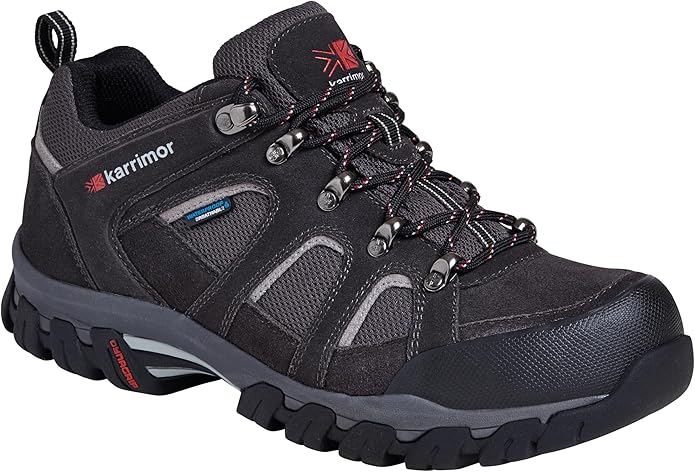
Mid-Range (£100-£190)
What you get: Good all-round boots, proven brands, reliable waterproofing
Best for: Regular day hikers, most UK hiking needs
Compromises: May lack some premium features, not top-tier materials
Recommendations: Scarpa Terra, Salomon Quest, Meindl Vakuum, Berghaus Explorer, Grisport Fuse
This is the sweet spot for most UK hikers.
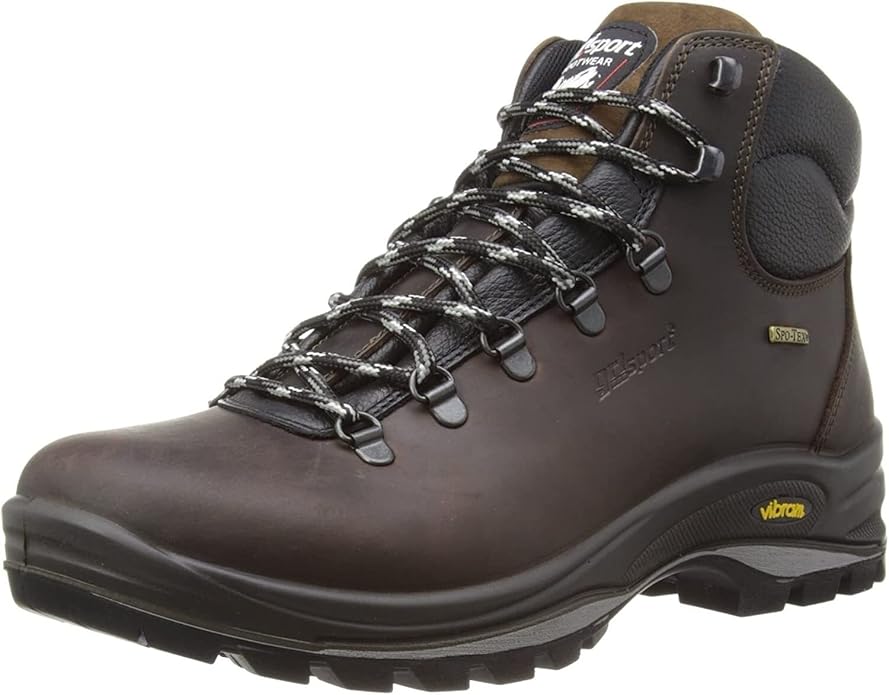
Premium (£190-£300+)
What you get: Exceptional durability, premium materials, advanced features
Best for: Serious hikers, challenging terrain, those who value longevity
Advantages: Will last 2-3x longer than budget boots, superior comfort, excellent performance
Recommendations: Scarpa Kinesis, Hanwag Tatra, Meindl Burma, Salewa Mountain Trainer
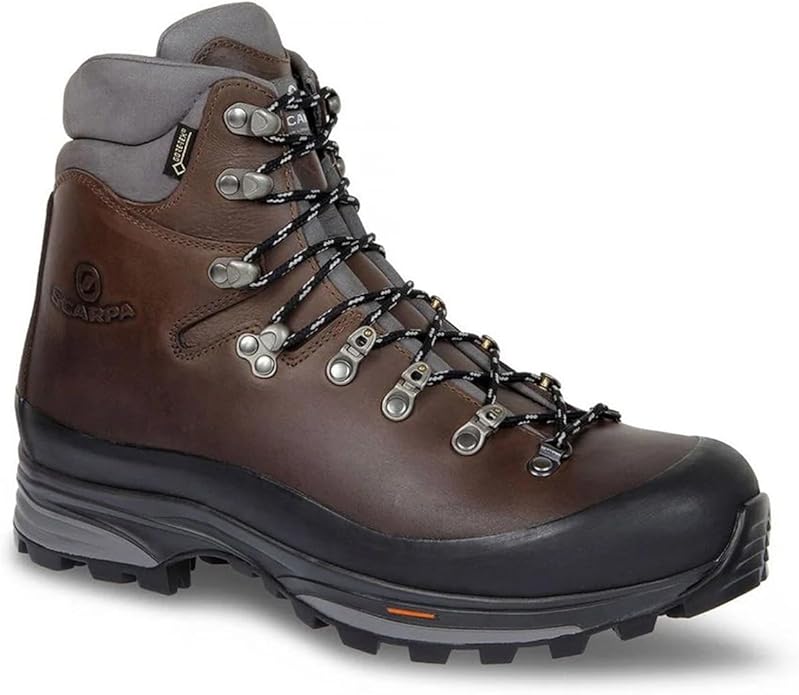
Ultra-Premium (£300+)
What you get: Top-tier leather boots, often Italian-made, potential crampon compatibility
Best for: Serious mountain use, winter hiking
Recommendations: Scarpa Mont Blanc, La Sportiva Nepal, Asolo Drifter
Cost-per-wear calculation: A £200 pair of boots lasting 1000 miles costs 20p per mile. A £80 pair lasting 300 miles costs 27p per mile. Quality boots are an investment.
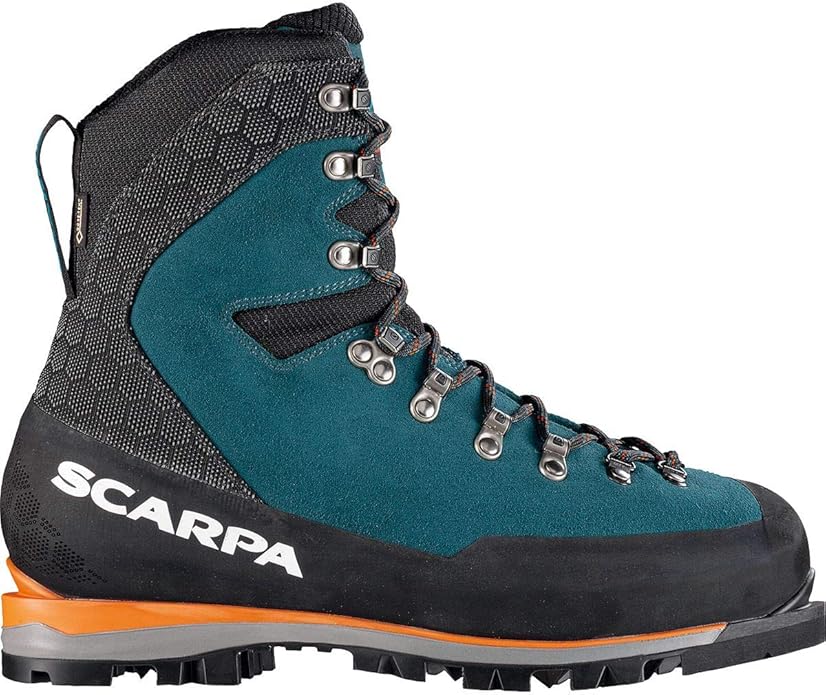
Popular Brands and What They’re Known For
Scarpa (Italy): Exceptional fit, durable, technical expertise. Higher price point but excellent value.
Salomon (France): Innovative designs, lighter weight focus, excellent for trail runners transitioning to hiking.
Meindl (Germany): Traditional construction, very comfortable, excellent for wider feet.
Berghaus (UK): Good value, designed for British conditions, readily available.
Grisport (Italy): Excellent quality at reasonable prices, often overlooked but highly regarded by regular hikers. Traditional construction meets modern materials. Great value for money, particularly their Fuse trekking boot and Crusader models. Popular with walking groups and clubs across the UK.
La Sportiva (Italy): Technical excellence, slightly narrower fit, favoured by mountaineers.
Hanwag (Germany): Premium leather boots, excellent durability, traditional craftsmanship.
Mammut (Switzerland): Technical innovation, good for mixed-terrain hiking.
Lowa (Germany): Wide range, very comfortable, good for various foot shapes.
Keen (USA): Wider toe box, good for broader feet, more casual styling.
Common Mistakes to Avoid
- Buying boots that are too small: “They’ll stretch” rarely applies to hiking boots. Size up if uncertain.
- Choosing boots for looks: Style should be the last consideration, not the first.
- Buying boots without trying them on: Online shopping is convenient but risky for boots. If buying online, ensure a good return policy.
- Ignoring your actual hiking: Don’t buy mountaineering boots for country walks. Match boots to your genuine use.
- Skipping the break-in period: New boots on a big hike = blisters and potential disaster.
- Not replacing worn boots: Sentimental attachment to old boots isn’t worth the risk of injury from degraded support and grip.
- Forgetting about socks: Boots and socks work as a system. Thin fashion socks with hiking boots are a recipe for blisters.
Final Recommendations by Activity
Casual rambler (6-10 walks per year, easy terrain): Mid-range lightweight hiking boot (Category B), £100-£140
Regular weekend hiker (20-30 walks per year, varied terrain): Good quality trekking boot (Category B+), £140-£200
Serious hiker (50+ days per year, all conditions): Premium leather trekking boot (Category C), £200-£300
Mountain enthusiast (year-round, challenging terrain): High-quality mountaineering-oriented boot (Category C/D), £250-£400
Making Your Decision
Choosing walking boots is personal. What works perfectly for your hiking partner might be uncomfortable for you. Focus on:
- Fit first: A cheaper boot that fits well beats an expensive boot that doesn’t
- Match to use: Be honest about your actual hiking, not aspirational adventures
- Try before you buy: Visit a specialist outdoor retailer with knowledgeable staff
- Break them in properly: Give new boots time to mold to your feet
- Maintain them well: Proper care extends boot life dramatically
The right walking boots transform hiking from a foot-focused endurance test into an enjoyable journey where you can focus on the landscape, the company, and the experience. Take your time choosing, invest in quality, and your boots will carry you across countless beautiful British miles.
Ready to hit the trail? With the right boots on your feet, every path becomes an invitation to explore. Whether it’s your first pair or your tenth, we hope this guide helps you find the perfect companions for your UK hiking adventures.
Happy trails, and may your boots be waterproof and your blisters non-existent!

Leave a Reply